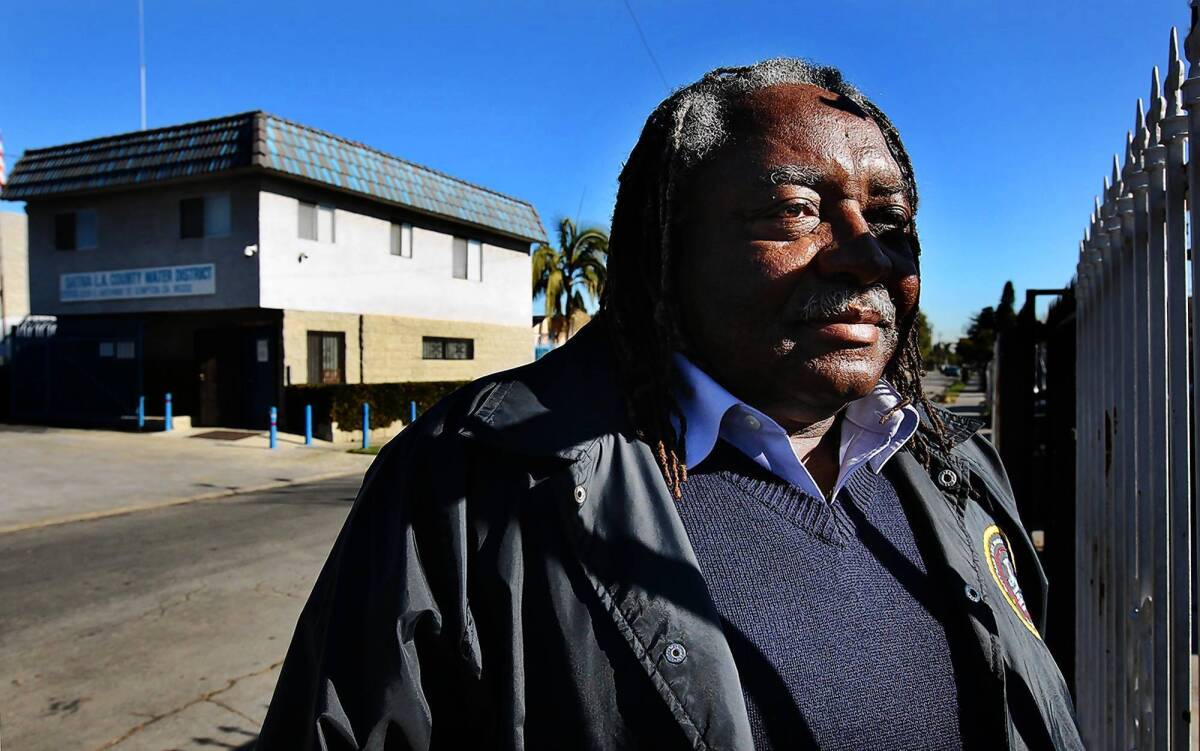Small water agencies come under increasing scrutiny

- Share via
In 1981, Johnny Johnson marched into the storefront headquarters of the tiny Sativa-Los Angeles County Water District in Willowbrook to complain about his water being shut off. He ended up deciding to run for a seat on the water board.
Johnson has been a leader of the district ever since. Now 68, he oversees a staff of six full-time employees, including his wife and stepdaughter.
For years, the district has operated without a budget, an auditor or a general manager. It can’t afford to install water meters at the 1,500 homes it serves just north of Compton.
And Johnson runs it like a one-man show: He oversees maintenance on wells, recently redesigned the district’s logo and has commissioned a series of murals around the neighborhood — including one that depicts him and three other Sativa board members.
In an era of government consolidation and efficiency efforts, Sativa and other small water districts are increasingly coming under government scrutiny. They have long been called inefficient and wasteful, and their operations are so obscure that public scrutiny is difficult.
Sativa, one of the smallest water districts in Southern California, is now the target of an investigation by government oversight officials who could disband it or merge it with a larger water provider.
Sativa’s own lawyer, James Ciampa, concedes the district hasn’t always followed financial reporting guidelines and said its board members had awarded themselves Christmas bonuses and bereavement pay not permitted under state law. Still, he and Johnson argued that the district works hard to serve its customers, and keeps rates and salaries low.
L.A. County’s Local Agency Formation Commission — the state-appointed body charged with monitoring special districts — recommended that Sativa be dissolved in 2005. But Johnson successfully pleaded for more time to fix the district’s problems. Now Sativa is under another LAFCO review, and Johnson is gearing up for another fight.
Getting rid of water districts remains a rare event. Paul Novak, executive director of LAFCO, said he could not recall the commission ever dissolving a water district. Orange County has seen somewhat more success, with officials saying the merger of several small districts reduced administrative costs and cut water rates. In L.A. County, there are more than 60 water agencies that each serve fewer than 10,000 people.
The patchwork of small agencies has contributed to a “culture of inefficiency” in the water business, said Adan Ortega, a local water expert. Districts often disagree with one another on policy issues, he said, or spend time battling over grant money. And small companies such as Sativa are usually left behind when it comes to major investments in new technology.
“The greatest danger of a lack of visibility is that people in charge of an agency can use public money inappropriately,” said Assemblyman Roger Dickinson (D-Sacramento). “Although I don’t think most of the people involved in special districts have bad intentions.”
Take the case of the Huntington Municipal Water District near Pasadena, another water agency currently facing a LAFCO review.
Huntington has never actually provided water to residents; that responsibility falls to Pasadena Water and Power, under a contract drawn up in 1931.
Instead, the district was formed in 1960 to block another water agency from taking over the Chapman Woods neighborhood’s water system, which serves about 470 homes. Huntington is overseen by a five-member board and collects a small amount of local property tax revenue. That money goes into a reserve fund that now contains about $250,000.
Harold Hennacy, Huntington’s treasurer, said he’d like to give the money back to taxpayers but is not sure how.
Huntington has no major expenses, and its board members are unpaid. As far as Hennacy and the other board members can tell, the district’s main job is to monitor the water rates set by Pasadena to make sure they’re fair. But members haven’t spoken before the Pasadena City Council in the last two decades.
“To be honest, I can’t remember the last time we met,” board member Ted Bartscherer said.
But Hennacy still believes the district should remain in place, saying it plays an important role as the community’s watchdog for water rates.
In Willowbrook, Johnson is also vowing that the Sativa district won’t be disbanded without a fight. He sees himself as a community advocate, much like the aldermen of his hometown in rural North Carolina.
In addition to running board meetings, Johnson oversees maintenance and acts as a first responder in emergencies. Most customers pay their bills in person each month at the district’s headquarters on Hatchway Street, a quiet residential block a few miles south of the 105 Freeway. Johnson knows many of them by their first names, and he said one of his main concerns is that a takeover of Sativa would come with a steep rate increase.
“I’d just hate to see the district lose its representation,” Johnson said. “If you don’t have a voice at all in water issues, that’s kind of ridiculous to me.”
He and the other board members meet regularly in a small room on the second floor. During a recent tour, Johnson pointed out a fresh set of state water code volumes and new promotional calendars the district printed to pass out to residents. He also noted improvements to Sativa’s well stations, which were once housed in tin shacks.
But there were also signs of financial struggle. The district’s headquarters has only one working computer, Johnson said, and much of its other office equipment was unplugged.
The most serious issues pertain to Sativa’s infrastructure. Johnson and Ciampa said the district has struck out repeatedly in its attempts to win grant money to install water meters. Sativa also needs to upgrade its aging pipe system, Johnson said, much of which was installed in the 1950s.
In 2005, a LAFCO consultant questioned whether Sativa had the resources to respond to a catastrophe. Johnson argues the district could always call on the U.S. government in a time of desperate need.
Sativa has also faced scrutiny over its financial practices. For years, the district failed to submit required audits to the state controller. Meanwhile, each board member received a $1,500 Christmas bonus. Ciampa said board members are working on a plan to repay the money and have hired new auditors. According to records made available by Sativa, Johnson, who is retired from the Navy, earned $11,000 from the district in 2011.
Johnson shrugged off questions about his family members’ employment, saying his wife worked there before they were married and that another official made the decision to hire her daughter.
In interviews, he emphasized that he was a “public servant, not a politician.”
“I keep getting reelected every four years,” Johnson said. “Evidently I must be doing something right.”
More to Read
Sign up for Essential California
The most important California stories and recommendations in your inbox every morning.
You may occasionally receive promotional content from the Los Angeles Times.











